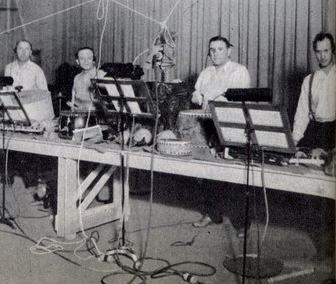Modern Mechanix re-published an article from 1937 on their blog , featuring fascinating stories about the use of sound in Mickey Mouse cartoons.
MUSIC and noises in the animated cartoon interpret the action of the story. The narrative theme of the music and what is called the “sound effects” punctuates and emphasizes the story.
By playing on the aural nerves with symbolic sounds and noises the psychological reaction of the audience is controlled and varied according to the dramatic and emotional needs of the cartoon story.
If Donald Duck falls, for example, it is not enough for the sound man to hit a drum for the noise, but an additional sound characteristic must be added to convey a certain kind of fall. There are dozens of different “sound effects” for cartoon character falls which vary according to the story. When a sympathetic attitude is desired, the “fall” sound is hollow and devoid of jarring characteristics, while a harsh sound which shocks the aural nerves is created for that effect.
The associative value of sounds is widely used for humor, such as a tearing noise which accompanies the falling of a character. For humorous responses the “sound effect” is often caricatured and distorted. An example of this was the tire skidding noise used in “The Tortoise and the Hare” when the fast moving rabbit slid to a stop.
Through study and experimentation Walt Disney and his engineers have found that by introducing music or various sounds and noise frequencies into the cartoon, the response of the audience is varied and controlled. By combining noises of certain pitches or tempos the psychological values of the cartoon music is emphasized in keeping with the story requirements.
Via: U.S.O Project.

very interesting article. great website btw.